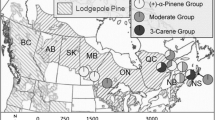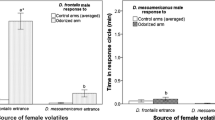Abstract
Females of a pinyon pine bark beetle,Ips hoppingi Lanier, were less attracted by the aggregation pheromone produced by conspecific males than by the pheromone produced by the neighboring sibling species,I. confusus (LeConte). Cross-attraction was elicited by males infesting the regional pinyon pine hosts (P. discolor andP. edulis) of eitherIps species in south-eastern Arizona. Pheromonal specificity has not accompanied speciation in this species pair.
Similar content being viewed by others
References
Bailey, D.K. 1987. A study ofPinus subsectionCembroides I: The single-needle pinyons of the Californias and the Great Basin.Notes R. Bot. Gard. Edinburgh, 44:275–310.
Bailey, D.K., andHawksworth, F.G. 1979. Pinyons of the Chihuahuan Desert region.Phytologia 44:129–133.
Betancourt, J.L. 1987. Paleoecology of pinyon-juniper woodlands: Summary. Proceedings, Pinyon-Juniper Conference, Reno, Nevada, January 13–16, 1986, U.S. Forest Service, USDA, Ge. Tech. Rep. INT, v. 215, pp. 129–139.
Borden, J.H. 1984. Semiochemical-mediated aggregation and dispersal in the Coleoptera, pp. 123–149,in T. Lewis (ed.). Insect Communication. Academic Press, New York.
Borden, J.H. 1985. Aggregation pheromones, pp. 257–285in G.A. Kerkut (ed.) Comprehensive Insect Physiology, Biochemistry and Pharmacology, Vol. 9. Pergamon Press, Oxford.
Cane, J.H., Wood, D.L., andFox, J.W. 1990. Ancestral semiochemical attraction persists for adjoining populations of siblingIps bark beetles (Coleoptera: Scolytidae).J. Chem. Ecol. 16:993–1013.
Jordon, D.S. 1905. The origin of species through isolation.Science 22: 545–562.
Lanier, G.N. 1970. Biosystematics of North AmericanIps (Coleoptera: Scolytidae) Hopping's group IX.Can. Entomol. 102:1139–1163.
Lanier, G.N., andWood, D.L. 1975. Specificity of response to pheromones in the genusIps.J. Chem. Ecol. 1:9–23.
Lanner, R.M., andVan Devender, T.R. 1981. Late Pleistocene pinion pines in the Chihuahuan Desert.Quat. Res. 15:278–290.
Sokal, R.R., andRohlf, F.J. 1981. Biometry, 2nd ed. W.H. Freeman, New York.
Thompson, R.S., andVan Devender, T.R. 1982. Late Pleistocene vegetational records from desert grassland in the Santa Catalina Mountains, Arizona.Am. Quat. Assoc. Abst. 7:167.
Wells, P.V. 1987. Systematics and distribution of pinyons in the late Quaternary. Proceedings. Pinyon-Juniper Conference, Reno, Nevada, January 13–16, 1986, U.S. Forest Service, USDA, Ge. Tech. Rep. INT, v. 215, pp. 104–108.
Wood, D.L. 1982. The role of pheromones, kairomones, and allomones in the host selection and colonization behavior of bark beetles.Annu. Rev. Entomol. 27:411–446.
Wood, S.L. 1982. The bark and ambrosia beetles of North and Central America.Mem. Great Basin Nat., 6:1359 pp.
Author information
Authors and Affiliations
Rights and permissions
About this article
Cite this article
Cane, J.H., Merrill, L.D. & Wood, D.L. Attraction of pinyon pine bark beetle,Ips hoppingi, to conspecific andI. confusus pheromones (Coleoptera: Scolytidae). J Chem Ecol 16, 2791–2798 (1990). https://doi.org/10.1007/BF00979473
Received:
Accepted:
Issue Date:
DOI: https://doi.org/10.1007/BF00979473




